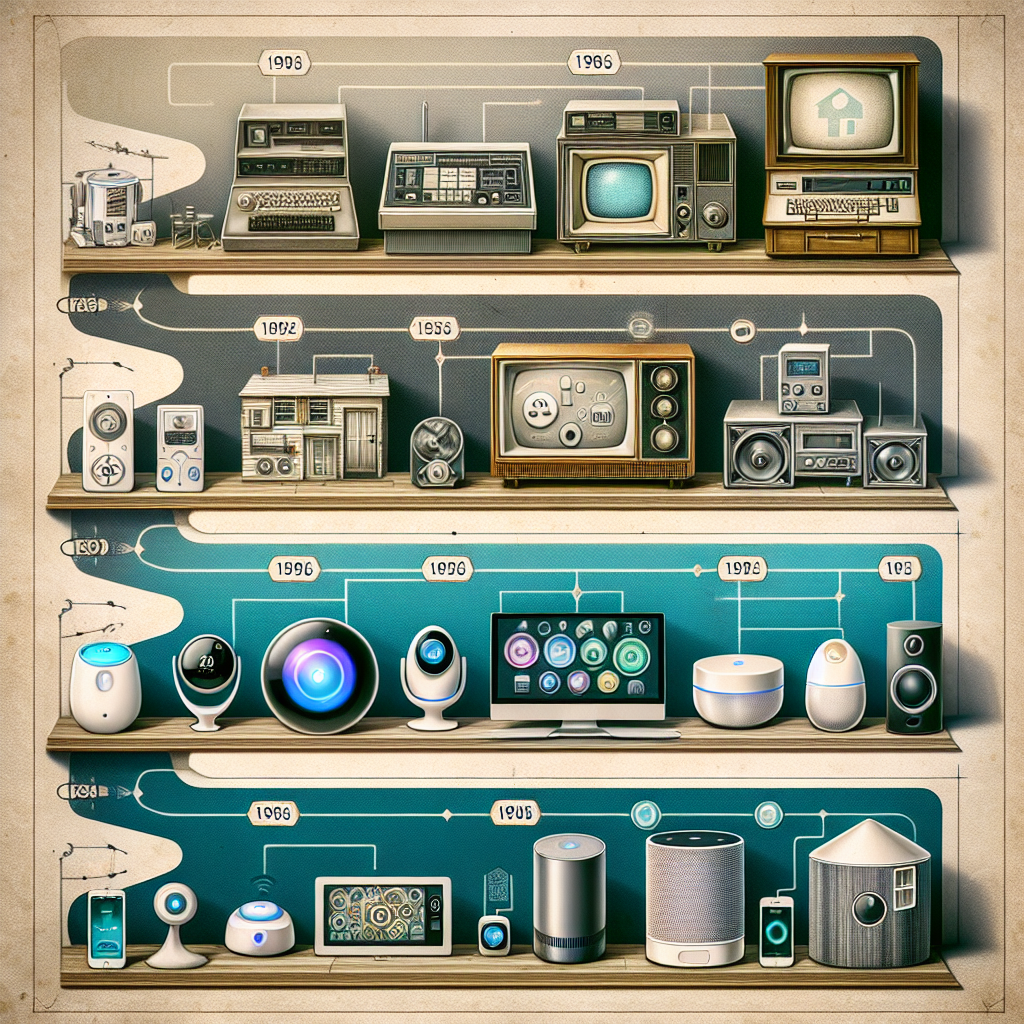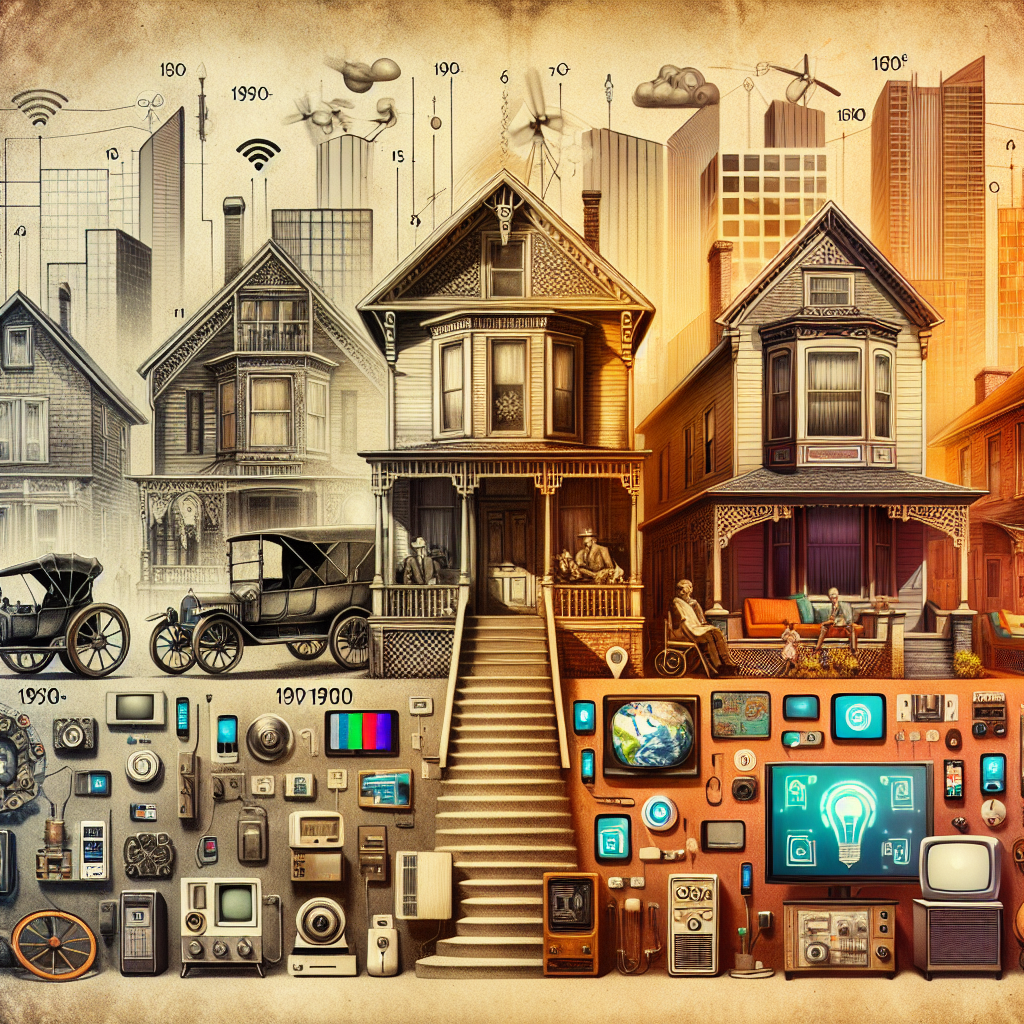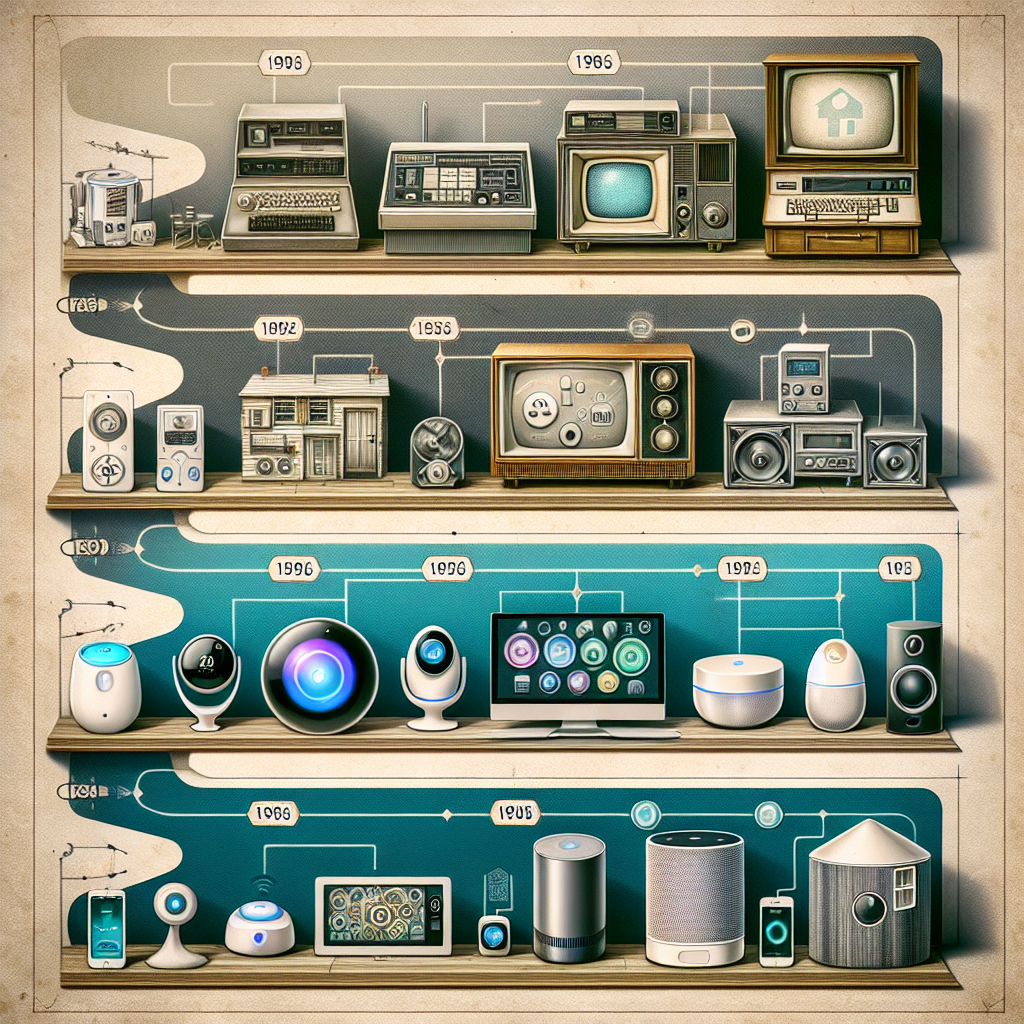In this article, you will embark on a fascinating journey through the history of smart home technology. From humble beginnings to the cutting-edge innovations of today, you will discover how smart homes have transformed the way we live. Explore the development of smart home devices, the integration of artificial intelligence, and the convenience they bring to our daily lives. Get ready to uncover the past, present, and future of this rapidly evolving technology.
Early Concepts of Smart Homes
The concept of home automation
Home automation, the concept of controlling and automating various household tasks and functions, has been a part of human imagination for centuries. The idea of having a home that responds to your commands or can anticipate your needs has always fascinated us. It was in the early 20th century when the concept of home automation began to take shape, although the technology was not yet advanced enough to fully realize this vision.
The development of early smart home technologies
The development of early smart home technologies can be traced back to the 1960s and 1970s. During this time, pioneers in the field of home automation, such as Jim Sutherland and Jerome Lemelson, filed patents for devices that could control various aspects of a home, including lighting, temperature, and appliances. These early technologies laid the foundation for the future advancements in smart home technology.
The use of X10 technology for home automation
In the 1970s, the X10 technology emerged as a significant breakthrough in the field of home automation. Developed by Pico Electronics, the X10 technology enabled communication between various electrical devices in the home using existing electrical wiring. This meant that homeowners could remotely control their lights, appliances, and other devices using simple commands.
The Rise of Internet Connectivity
The development of internet connectivity in homes
The late 20th century saw a rapid expansion of internet connectivity in homes. With the advent of personal computers and the internet, households gained access to a wealth of information and communication opportunities. The internet became an essential part of our lives, and soon, it would pave the way for the integration of smart home technology.
The integration of internet with smart home technology
As internet connectivity became more widespread, the idea of connecting home automation systems to the internet gained traction. This integration would allow homeowners to control and monitor their smart devices remotely, even when they were not at home. It opened up a whole new realm of possibilities for smart homes, making them more accessible and convenient.
The introduction of Wi-Fi enabled devices for smart homes
The introduction of Wi-Fi technology in the late 1990s revolutionized the way we connect and communicate. Wi-Fi enabled devices became increasingly popular, and it wasn’t long before they found their way into smart homes. Wi-Fi enabled smart devices allowed for seamless communication and control, eliminating the need for complex wiring and expensive installations. This development made smart homes more practical and accessible to a wider range of homeowners.

Smart Home Hubs and Voice Control
The emergence of smart home hubs
Smart home hubs, also known as central control units, play a crucial role in managing and coordinating various smart devices in a home. These hubs act as a central point of control, allowing users to interact with their smart devices and systems through a centralized interface. With the emergence of smart home hubs, homeowners gained greater control and convenience in managing their smart homes.
The integration of voice control in smart homes
Voice control emerged as a game-changer in the world of smart home technology. With voice assistants like Amazon Alexa and Google Assistant, homeowners could now control their smart devices through simple voice commands. Whether it’s adjusting the thermostat, turning on the lights, or playing music, voice control allowed for a more intuitive and hands-free experience in smart homes.
The role of virtual assistants in smart home technology
Virtual assistants, powered by artificial intelligence, have become an integral part of smart home technology. These intelligent programs, such as Amazon Alexa or Google Assistant, can understand and respond to voice commands, provide information, and even perform tasks beyond controlling smart devices. They have become valuable companions in smart homes, making daily tasks and routines more efficient and enjoyable.
Smart Home Security Systems
The development of security systems for smart homes
The security of our homes has always been a top priority. With the advent of smart home technology, traditional security systems saw significant advancements. Smart home security systems combine state-of-the-art technology with intelligent automation to provide a comprehensive and integrated approach to home security. These systems offer features such as door and window sensors, motion detectors, and alarms, all connected to a central control hub.
The integration of cameras and sensors for home security
Cameras and sensors have become indispensable components of smart home security systems. High-definition security cameras can stream live video feeds to homeowners’ devices, allowing them to monitor their homes remotely. Motion sensors can detect any unauthorized movement and trigger alarms or send notifications to the homeowner. These advanced technologies provide homeowners with peace of mind and enhanced security for their smart homes.
The use of biometric authentication in smart homes
Biometric authentication has found its way into smart homes to provide an extra layer of security. Biometric data, such as fingerprints or iris scans, can be used to identify authorized users and grant them access to different areas of the home. This technology ensures that only authorized individuals can control the smart devices in the home, enhancing privacy and security for homeowners.

Energy Efficiency and Sustainability
The focus on energy efficiency in smart home technology
As the importance of sustainable living grew, so did the focus on energy efficiency in smart home technology. Smart homes offer various features and solutions aimed at reducing energy consumption and promoting sustainable practices. From smart thermostats that learn and adjust to homeowners’ preferences, to energy monitoring devices that provide real-time insights into energy usage, smart homes empower homeowners to make informed decisions and reduce their carbon footprint.
The development of smart thermostats and energy monitoring devices
Smart thermostats have become one of the most popular energy-efficient devices in smart homes. These devices learn homeowners’ behavior and preferences and automatically adjust the temperature settings to optimize energy usage. Energy monitoring devices, on the other hand, provide real-time data on energy consumption, helping homeowners identify areas where energy is being wasted and make adjustments accordingly. Together, these technologies enable homeowners to save energy and reduce utility costs.
The integration of renewable energy sources in smart homes
Smart homes have embraced the integration of renewable energy sources to further enhance energy efficiency and sustainability. Solar panels, for example, can be connected to a smart home system, allowing homeowners to generate their own clean energy. Smart home technology can optimize the use of renewable energy sources, ensuring that energy is efficiently distributed and stored, providing homeowners with a greener and more sustainable energy solution.
Smart Lighting and Appliance Control
The evolution of smart lighting systems
Smart lighting systems have come a long way since the early concepts of home automation. Today, homeowners can control their lights with a simple voice command or through a smart device app. Smart lighting systems offer various features, such as dimming capabilities, color-changing options, and scheduling, empowering homeowners to create personalized lighting experiences and enhance the ambiance in their homes.
The introduction of smart appliances and connected devices
The evolution of smart home technology has led to the introduction of a wide range of smart appliances and connected devices. From smart refrigerators that can create shopping lists and notify homeowners of expired food, to smart TVs that can stream content directly from the internet, these devices have transformed our homes into intelligent spaces. These appliances and devices can be controlled and monitored remotely, providing homeowners with convenience and efficiency.
The automation of home appliances through smart technology
Smart technology has enabled the automation of home appliances, making everyday tasks easier and more efficient. For example, homeowners can schedule their washing machine to start a load of laundry while they are at work, or preheat the oven before they even step foot in the kitchen. This automation not only saves time and effort but also optimizes energy usage, making our homes more eco-friendly.
Healthcare and Wellness Applications
The integration of healthcare monitoring systems in smart homes
Smart homes have also extended their benefits to healthcare and wellness applications. With the integration of healthcare monitoring systems, individuals can monitor vital signs, such as heart rate and blood pressure, from the comfort of their homes. This technology allows for early detection of health issues and enables healthcare providers to remotely monitor patients, providing timely and personalized care.
The use of wearable devices for health tracking
Wearable devices, such as fitness trackers and smartwatches, have become increasingly popular in recent years. These devices, when integrated with smart home technology, can provide valuable insights into an individual’s overall health and well-being. They can track steps taken, calories burned, sleep patterns, and even monitor stress levels. By combining data from wearable devices with smart home systems, individuals can take proactive steps towards a healthier lifestyle.
The development of smart home solutions for independent living
Smart home technology has proven to be a boon for individuals who wish to age in place or live independently. With features such as fall detection systems, voice-activated emergency alerts, and remote care monitoring, smart homes provide a sense of security and assistance for those who may require additional support. These solutions allow individuals to maintain their independence and quality of life while ensuring their safety and well-being.
The Internet of Things (IoT) in Smart Homes
The concept of the Internet of Things (IoT)
The Internet of Things (IoT) refers to the network of interconnected devices and systems that can communicate and exchange data with each other over the internet. In the context of smart homes, IoT represents the integration of various smart devices and systems to create a seamless and interconnected ecosystem. This connectivity allows for greater automation, control, and efficiency in managing and operating smart home technology.
The role of IoT in smart home technology
IoT plays a fundamental role in the advancement of smart home technology. It enables devices and systems to communicate with each other, share data, and respond intelligently to user commands. IoT technology allows for seamless integration and interoperability among different smart devices, creating a cohesive and unified smart home experience for homeowners.
The benefits and challenges of IoT in smart homes
The benefits of IoT in smart homes are far-reaching. It enables homeowners to have greater control, convenience, and efficiency in managing their homes. With IoT, homeowners can remotely control their devices, receive real-time updates, and automate routine tasks. However, the rapid expansion of IoT in smart homes also presents challenges such as privacy and security concerns. It is essential for manufacturers and users to prioritize data protection and implement robust security measures to mitigate these risks.
Artificial Intelligence and Machine Learning
The integration of AI and machine learning in smart home technology
Artificial intelligence (AI) and machine learning have revolutionized the capabilities of smart home technology. AI algorithms and machine learning models enable smart devices to understand patterns, learn user preferences, and anticipate homeowners’ needs. This integration allows for personalized automation and a more intuitive user experience in smart homes.
The advancements in natural language processing and machine vision
Advancements in natural language processing (NLP) and machine vision have greatly enhanced the functionality of smart home technology. NLP allows users to interact with their smart devices through voice commands, enabling them to control various systems and access information effortlessly. Machine vision, on the other hand, enables devices to perceive and interpret visual data, such as facial recognition or object detection, enhancing security and personalization in smart homes.
The potential of AI for personalized automation in smart homes
AI holds tremendous potential for personalized automation in smart homes. As AI algorithms continue to improve, smart devices will become more adept at understanding and predicting homeowners’ preferences and behaviors. This means that homes can adapt to individual needs, adjusting lighting, temperature, and other settings automatically. AI-powered automation allows for a seamless and personalized living experience, making smart homes truly intelligent and intuitive.
The Future of Smart Home Technology
Emerging trends and technologies in smart homes
The future of smart home technology looks promising, with several emerging trends and technologies on the horizon. One such trend is the increased integration of augmented reality (AR) and virtual reality (VR) in smart homes, allowing homeowners to visualize and interact with their smart devices in immersive and innovative ways. Additionally, the development of 5G networks will bring faster and more reliable communication between smart devices, enabling even greater connectivity and automation.
The adoption of smart home technology in different sectors
Smart home technology is not limited to residential applications alone. Industries such as hospitality, healthcare, and commercial spaces are also embracing smart home solutions to enhance customer experiences and improve operational efficiency. Smart hotels, for example, can offer personalized room settings and seamless guest interactions, while smart offices can optimize energy usage and improve productivity. The adoption of smart home technology in these sectors is expected to grow exponentially in the coming years.
The challenges and opportunities for the future of smart homes
While the future of smart home technology is filled with endless possibilities, it also presents challenges that need to be addressed. Privacy and security concerns will need to be carefully managed to ensure the protection of personal data in an increasingly connected world. Additionally, interoperability standards and compatibility between different devices and systems will be crucial for creating a seamless and user-friendly smart home experience. However, with innovation and collaboration, the future of smart homes holds tremendous opportunities for improving our quality of life and making our homes more efficient, comfortable, and sustainable.
In conclusion, the evolution of smart home technology has transformed the way we interact with and manage our homes. From early concepts of home automation to the integration of IoT, AI, and machine learning, smart homes have become a reality that offers convenience, comfort, and sustainability. The future of smart home technology holds great promise, with emerging trends and technologies shaping the way we live and interact with our living spaces. As we embrace the potential of smart homes, it is important to address challenges and ensure that privacy, security, and interoperability are prioritized. With careful consideration and continued advancements, smart homes will continue to revolutionize our daily lives and pave the way for a smarter and more connected future.

